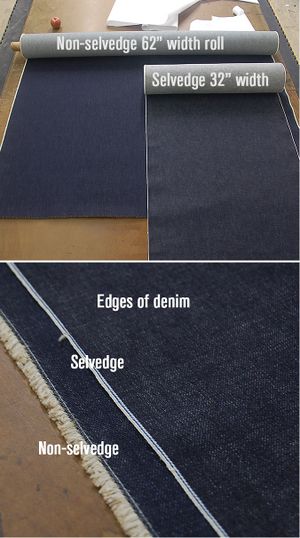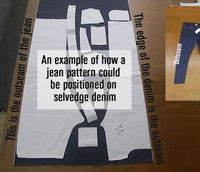Denim 101
Page is under construction. Some of this information is a little off and it's messy; I'm going through it.
Contents
Selvedge and Raw
The two are often confused or conflated for one another, but "raw" and "selvedge" are two fundamentally different properties of denim (and, more broadly, of fabric). "Selvedge" refers to the type of fabric that the jeans are made of whereas "raw" denotes the unwashed state of the jeans (that is, the jeans haven't been washed after the color treatment process during production). The telltale sign of jeans made with selvedge denim is the so-called "selvedge line" or white taping that runs down the outseam on the inside of a pair of jeans. Raw jeans, on the other hand, can be identified by their uniform, dark indigo color and the stiffness of their fabric.
Raw jeans don't have to be selvedge and selvedge jeans don't have to be raw. Furthermore, neither of these qualities necessarily denotes the quality of the denim. What, then, is the connection between the two and why are the terms so important?
First, let's talk a little more about what selvedge means.
Dry or Raw denim is denim fabric that is not washed during the production phase, after the color treatment process.
Selvage (or Selvedge, Self-edge) is a type of denim made on an old style shuttle loom which creates the unique edge that is typically used on the outseam of jeans. The result is a clean edge where the denim fabric is stitched together that can't be frayed like non-selvage jeans.
The shuttle looms which make selvage denim are smaller and produce fabric which is narrower (about 32”) than modern, wide projectile looms. Furthermore, the process tends to produce a tighter weave, requiring more material to produce an equivalent yardage. While this makes for a more appealing fabric, it costs more to produce, which is why many denim manufacturers switched to wider projectile looms in the mid to late 1900s.
Nowadays, most jeans are made using fabric produced on wide projectile looms. These looms produce more fabric more quickly and use less cotton per square yard. The fabric doesn't "complete" the way that selvedge fabric does, and thus the outseam needs to be sewn to prevent fraying.
None of this is to say that non selvedge fabric makes for "bad" jeans, but selvedge does make for a more authentic jean with a more visually appealing seam and more interesting fabric to the discerning viewer. Whether you're buying selvedge or non selvedge jeans, quality is often a reflection of cost, though. Expect to spend over $100 at retail for a decent pair whether or not you decide to buy a selvedge pair. Also note that the price difference between a selvedge and nonselvedge jean at this level might be completely negligible depending on the brand.
Why Buy Raw?
Simple. Buy an unwashed pair of denim and as you wear them more and more you watch the denim progress. Usually with denim like 7 for All Mankind and Rock and Republic, the denim goes through series of washing process to give it a worn look. Raw denim is unwashed before being sold. With wear, the denim loosens and fades which will form to your body. With every wear, creases will form and eventually indigo rubs off. The color will fade creating patterns. This is typical in higher stress areas such as whiskers (upper thigh creases), honeycombs (behind the knee creases), and down the thigh to the knee. You are creating what is seen on a typical wash on many designer jeans (since many washes try to mimic a natural fade).
Sanforization
Sanforizing the denim is the process of evening out the shrinkage and has no effect on the color or quality. When the denim is sanforized, it is already shrunk for you. Most denim nowadays is sanforized so when you finally wash the denim it shouldn’t shrink that much. Some Japanese denim manufactures, however, specialize in unsanforized jeans like Flat Head and Iron Heart. Unsanforized denim should be soaked BEFORE you wear them, that way you shrink them down ahead of time so you won't have uneven fades when you eventually wash them. Also, the denim will stretch with wear (less than 10%). Every brand is different.
Indigo Staining
Under certain conditions, raw jeans can transfer indigo dye onto other clothes and upholstery. Different jeans will bleed to different extents but generally speaking, rough or repeated physical contact with light colored items, or contact with wet or damp light colored items will encourage color transfer. Be careful wearing whites and light colored shoes (canvas and even suede) with raw jeans. Cuffing can reduce the chance of color bleeding onto your shoes, though. I've even heard of people taping the inside of their pants to prevent staining, but this is a pretty extreme measure. Wet items will pick up indigo very easily, however. I once rinsed a white shirt to remove a stain only to have it stained blue wear it came in contact with my jeans. Needless to say, consider wearing something else if there is rain in the forecast.
Altogether, staining isn't a tremendous concern, but is something to be aware of. If it does concern you that much, consider soaking your raw jeans before wearing them. An initial soak will remove some of the excess dye and starch left over from the production process and shouldn't affect fading much later on.
If you do stain your clothing with indigo, try using saddle soap or Fels-Naptha (which I've personally had success with) to wash it out. And, as with any stain, work quickly if possible, and don't allow to dry and set in.
Washing & Soaking
The rule of thumb (if you're looking for pronounced or high contrast fading) is to wait at least 6 months to wash raw jeans. This is just a guideline, though. If you sit around in your raws all day posting on /fa/, it'll take longer to get fades than someone who's moving about a lot. Your best option is pay attention to how the jeans are fading by themselves. With wear you'll notice highlights around creases or stress points. When you start to see noticeable fading along the whiskers (creases around the crotch) and honeycombs (creases behind the knee), it might be time to wash your jeans.
The basic method of washing them is rather simple: fill a tub with room temperature water, add in a color safe detergent like Woolite Black, turn the jeans inside out, lay them flat in the tub, gently submerge for 1-2 hours, rinse with cold water, and then hang dry.
If you don't care about fades or dye loss, you should still line dry and wash with care. Dryers can cause really unfavorable shrinkage and change the look of the fabric.
If your jeans start to stink from excessive wear, Fabreeze and an extended line dry can help. One thing that doesn't work: the infamous freezer method. Freezing your jeans might seem to get rid of the smell temporarily, but trust me, it'll be back (and pretty quickly).
Hemming
Raw denim usually comes with very long inseams. If they're longer than you want, you can simply have them hemmed (this will cost anywhere between $5-25 depending on the tailor and the type of hem (that $25 price would be a chain stitch from Self Edge). Remember that even if your jeans are sanforized you might still see some shrinkage when you wash (in some cases up to 2" in length). Some people recommend waiting until after the first wash before soaking, but honestly you can just have them hemmed and leave yourself a little wiggle room (say, take the seam down to a 32" if what you really want is a 30". Washing in cold water and line drying will further reduce the chances of unwanted shrinkage.
Some people like the extra inseam, though, to cuff or create mad stacks. Ultimately it's personal preference.
A List of Recommended Brands
Under $100
- GAP
- Uniqlo
- Levis
- Cheap Monday
- Unbranded $78+, Made in Macau of Japanese denim
- J.Crew $96+
$100-200
- Gustin $99, Made in SF, USA of Japanese denim
- Williamsburg Garment Company $105+, Made in the USA and imported styles, Japanese denim
- April 77 $130+
- United Dry Stock Goods $135+ Made in USA of Japanese denim
- Naked and Famous $135+ ; Made in Canada, Japanese denim (Gilt often sells them for $89)
- Left Field NYC $175+ ; Made in the USA, Cone Mills denim
- Nudie $179+ made in Italy, denim from Italy, Japan, and Turkey
- APC $185+ Made in Macau, Japanese denim
- BLK DNM $190+
$200-300
- Edwin $200+ Made in Japan, Japanese denim
- ACNE $200+ Made in Turkey, Italy, Albania
- Rogue Territory $210+; Made in the USA; Nihon Menpu Mills denim, Cone Mills denim
- 3sixteen $215+ made in USA, Kuroki Mills denim, Japanese Denim
- Tellason $220+ made in USA, Cone Mills denim
- Levi's Vintage Clothing $250+ (for 501xx) Cone Mills denim, Made in USA
- Pure Blue Japan $275 Made in Japan, Japanese denim
$300&UP
- Momotaro $315+ Made in Japan, Japanese denim
- Roy $335+ Made in USA, Cone Mills denim
- Samurai $345+ Japanese denim, Made in Japan
- Iron Heart $360+ Made in Japan, Japanese denim
- Flat Head $335 Made in Japan, Japanese denim
- Dior $390+
Resources and Retailers:
Info
What is Selvedge Denim? a visual run down of selvedge and how it differs from non selvedge.
Rawr Denim, a great resource. Check out their "fade friday."
Selvedge Myth Busting. Take this info with a grain of salt.
Shops
Tate + Yoko (Canada)
Superdenim (UK)


